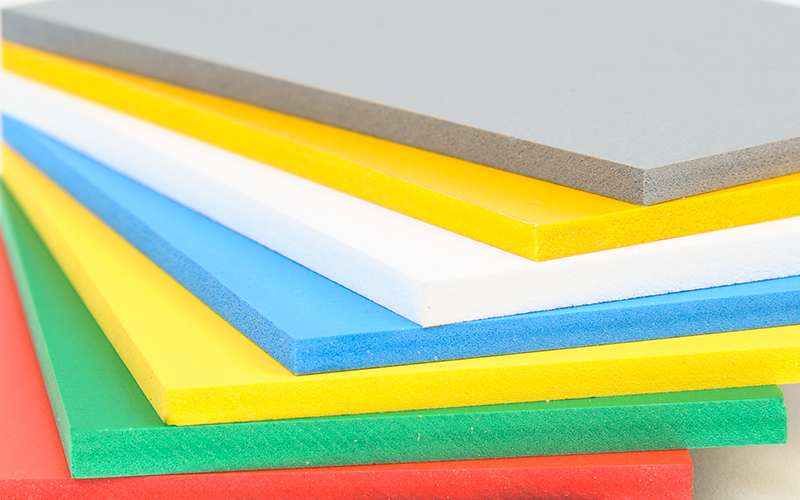PVC is a very versatile material that is easy to work with. But what is the difference between solid PVC and foamed PVC? Does one material have advantages over the other? This page will tell you everything you want to know about these two types of PVC, and PVC in general.
Types of PVC
In our wide range, you will find two types of PVC: solid PVC & foamed PVC. Solid PVC and foamed PVC are two different variants of PVC sheets, and each has its own properties.
| Solid PVC | Foamed PVC | |
|---|---|---|
| Sheet type | Solid sheet | Solid top layers with foamed core |
| Impact-resistant | Yes | No |
| Machinability | Good | Good |
| Price | Inexpensive | Inexpensive |
| Total colours | 2 colours | 5+ colours |
| Sheet thickness (mm) | 2, 3, 4, 5, 6, 8, 10, 12, 15, 20 | 2, 3, 4, 5, 6, 8, 10, 13, 19 |
| UV-resistant | No | No |
| Damp-proof | Yes | Yes |
| Recyclable | Yes | Yes |
| Recycled | Yes | Yes (Foamed PVC ECO) |
Other names for PVC
PVC can be divided into different categories based on properties, production methods and intended use. For example, some types of PVC use plasticisers and are flexible. We do not offer these types of PVC. Plasticisers are widely criticised for their health risks. Some common names for PVC are:
| Type | Applications | Plasticisers | In our product range | |
|---|---|---|---|---|
| Unplasticised PVC (uPVC) | Solid strong form of PVC | Window frames, Cladding, Pipes | None | Yes |
| Plasticised PVC (pPVC) | Flexible and soft | Electric cables, Floors, Inflatable products | Yes | No |
| Chlorinated PVC (CPVC) | Higher temperature resistance and better mechanical properties | Hot water pipes, Industrial- pipe systems, Sprinkler systems | Yes | No |
| Molecularly Oriented PVC (PVC-O) | Molecularly oriented (stronger and tougher) | Water pipes, Pressure applications | None | No |
Chemical properties of PVC
PVC (polyvinyl chloride) is a thermoplastic polymer, and is composed of vinyl chloride monomers. It is therefore a synthetic plastic with several important properties, such as:
- Chemical stability: PVC is resistant to many chemicals, including acids, alkalis and salts.
- Flame resistance: PVC is hardly flammable and to some extent flame retardant.
- Durability: PVC is a highly durable material that can withstand harsh environmental conditions, moisture and higher temperatures.
- Insulating properties: PVC is a good electrical insulator, making it useful in electrical applications.
- Very hygienic: PVC is very hygienic as bacteria and similar items cannot adhere well to the material. Therefore, it is often used in medical and food processing applications.
Density: PVC has a density of 1.38-1.59 g/cm³, which is lower than many other plastics.
Manufacturing process of PVC
PVC is a sturdy and robust sheet that does not contain plasticiser, which makes it very durable. Making these strong sheets requires a unique manufacturing process, which includes several steps:
steps
-
Polymerisation
The process starts with the polymerisation of vinyl chloride monomer (VCM) to form polyvinyl chloride (PVC) resin. The VCM is subjected to high pressure and temperatures to initiate the reaction, which is catalysed by a peroxide or other initiators. The polymerisation reaction results in the formation of powdered PVC resin.
-
Mixing
The PVC resin is then mixed with various additives, such as stabilisers, lubricants and pigments. This improves its properties and performance. The additives are mixed with the PVC resin to form a homogeneous mixture.
-
Extrusion
The PVC mixture is then fed into an extruder, a machine that melts the mixture and pushes it through a die to form a continuous profile. The profile can have different shapes and sizes, depending on the design specifications.
-
Cooling
The extruded profile is cooled by passing it through a water bath or air cooling system to solidify it and maintain its shape
-
Cutting and finishing
The cooled profile is then cut to the desired length and finished according to specific application requirements, such as drilling holes, welding or gluing.
In general, the manufacturing process of PVC is similar to that of other PVC products, but the absence of plasticisers makes it a sturdier and more durable material, suitable for various applications.
Applications of PVC
PVC is a very versatile material and is therefore used for many applications. PVC is mainly found in industries such as construction, healthcare, automotive and consumer goods.
Construction
PVC is the most widely used plastic in construction. This is due to the durable, weather-resistant and low-maintenance properties of this robust material. PVC is often used for this purpose:
- Pipe systems
- Profiles
- Flooring
- Cable insulation
- Roofing.
Healthcare
PVC is commonly used in healthcare, because of the material’s flexibility, transparency and hygienic properties. Healthcare PVC is often not PVC sheets, but flexible variants, such as for:
- Medical pipes
- Blood bags
- Infusion bags.
Automotive
In the automotive industry, PVC is used because of its durability, low maintenance and wide range of colours and textures. Applications of PVC in the automotive sector can include:
- Interior and exterior cladding
- Electrical insulation
- Hoses
- Fuel lines
- Coolant hoses
- Vacuum lines
Consumer goods
Because PVC is made in different shapes and sizes, and is often lightweight and transparent, PVC is often found in many consumer goods. It is durable, colourful and can be formed into different shapes. PVC applications in consumer goods include:
- Packaging
- Toys
- Inflatable products
- Boats
Available colours and thicknesses
Both solid PVC and foamed PVC are available in our webshop in various colours and thicknesses. Foamed PVC in particular offers a number of special colours.
Thicknesses
Colours
What are the processing possibilities of PVC?
Both solid and foamed PVC can be processed in various ways. Processing options for solid PVC include cutting, drilling, welding, printing. Foamed PVC is also suitable for cutting and printing. Milling is also an option.
Below you will find all the processing options for solid PVC and foamed PVC.
Solid PVC
Foamed PVC
Assembling PVC
Solid and foamed PVC can be mounted in different ways. The choice between the different methods depends on the application and your desired result.
Solid PVC can easily be mounted with screws, nails or glue. You can also mount solid PVC with brackets or clips such as spacers.
Foamed PVC is more vulnerable than solid PVC, and therefore requires more care when mounting. You can mount foamed PVC with glue because of its light weight, or with mounting stands that hold the panel in place and provide extra support.
What are the properties of PVC?
Both types of PVC each have their own unique properties. Below, we have listed the properties in advantages and disadvantages for you for solid and foamed PVC.
Solid PVC
Advantages of solid PVC
– Chemical resistance
– Strong and durable
– Easy to maintain
– Moisture resistant
– Mould resistant
– Easy to process
– Lifetime of 30+ years
Disadvantages of solid PVC
– Not suitable for exposure to very extreme weather conditions
Foamed PVC
Advantages of foamed PVC
- Light weight
- Chemical resistant
- High insulation value
- Aesthetic
- Easy-care
- Moisture-resistant
- Easy to work with
- Lifetime of 30+ years
Disadvantages of foamed PVC
- Less strong than solid PVC
- Not suitable for exposure to very extreme weather conditions
How do I maintain PVC?
Both solid PVC and foamed PVC are very easy to maintain. It is recommended to clean the material once in a while with mild soapy water and a soft cloth. Do not use aggressive agents or objects when cleaning both types of PVC.



















